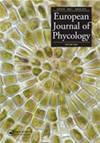Distribution, identification and cytotoxicity of Gambierdiscus (Dinophyceae) in the Atlantic Selvagens Islands (Madeira, Portugal): a ciguatera gateway to Europe
IF 1.7
4区 生物学
Q2 MARINE & FRESHWATER BIOLOGY
引用次数: 4
Abstract
ABSTRACT The emerging threat of ciguatera poisoning (CP) in Europe has been associated with fish captured in the Canary Islands (Spain) and Selvagens Islands (Portugal). The first are heavily populated islands where numerous scientific studies have been carried out. Conversely, the Selvagens Islands as a nature reserve with low human pressure have been rarely surveyed in terms of the marine benthic microalgae, including the epiphytic ciguatera-causing dinoflagellate species. To investigate the harmful microalgal diversity of the Selvagens Islands, a scientific cruise to these remote islands took place in September, 2018. The Gambierdiscus species composition and distribution, and the associated epiphytic dinoflagellate community, were assessed using artificial substrate devices. Gambierdiscus cells were found in all samples, reaching concentrations of up to 725 cells 100 cm–2. G. australes was the only species identified after morphological and molecular analysis of the retrieved cultures. Species identification was confirmed by molecular characterization based on the LSU D8–D10 region. Nevertheless, phylogenetic studies indicated that some strains diverged from the G. australes clade suggesting genetic differentiation. Toxicity was estimated by neuro-2a cell-based assay in four strains, ranging from 2.46–83 fg of CTX1B eq. cell–1. The epiphytic dinoflagellate community that co-occurred with Gambierdiscus comprised other toxic or potentially toxic dinoflagellates, such as Ostreopsis, Prorocentrum, Amphidinium and Coolia species. Oceanographic and meteorological data were also obtained to characterize the occurrence of Gambierdiscus. This study is the first stage in understanding the role of the Selvagens Islands in the incubation and proliferation of the ciguatera-causing dinoflagellates Gambierdiscus in the NE Atlantic. Highlights The Selvagens Islands are a ciguatera hotspot in Europe. Gambierdiscus australes was the only species observed in the Selvagens Islands. Strains diverging from the G. australes clade suggest genetic differentiation.大西洋塞尔瓦根斯群岛(葡萄牙马德拉岛)的甘比尔铁饼(恐龙科)的分布、鉴定和细胞毒性:通往欧洲的雪卡鱼门户
摘要:欧洲新出现的雪卡毒威胁与加那利群岛(西班牙)和塞尔瓦根斯群岛(葡萄牙)捕获的鱼类有关。第一个是人口稠密的岛屿,在那里进行了大量的科学研究。相反,塞尔瓦根斯群岛作为一个人类压力较低的自然保护区,很少对海洋底栖微藻进行调查,包括引起附生雪卡的甲藻物种。为了调查塞尔瓦根群岛有害的微藻多样性,2018年9月对这些偏远岛屿进行了科学考察。使用人工基质设备评估了甘比尔盘虫的物种组成和分布,以及相关的附生甲藻群落。在所有样本中都发现了甘比尔铁饼细胞,其浓度高达725个细胞100 cm–2。澳大利亚G.australes是对检索到的培养物进行形态学和分子分析后确定的唯一物种。基于LSU D8–D10区域的分子表征证实了物种鉴定。尽管如此,系统发育研究表明,一些菌株与南方G.australes分支分化,表明存在遗传分化。通过基于神经-2a细胞的测定对四种菌株的毒性进行了评估,CTX1B当量细胞-1的毒性范围为2.46–83 fg。与Gambierdiscus共同存在的附生甲藻群落包括其他有毒或潜在有毒的甲藻,如Osteopsis、Prorocentrum、Amphinium和Coolia物种。还获得了海洋和气象数据来表征甘比尔铁饼的发生。这项研究是了解塞尔瓦根群岛在东北大西洋引起雪卡鱼的甲藻Gambierdiscus的孵化和增殖中的作用的第一阶段。亮点塞尔瓦根斯群岛是欧洲的雪卡热点。南方甘比尔铁饼是在塞尔瓦根群岛观察到的唯一物种。从南方G.australes分支分化的菌株表明遗传分化。
本文章由计算机程序翻译,如有差异,请以英文原文为准。
求助全文
约1分钟内获得全文
求助全文
来源期刊

European Journal of Phycology
生物-海洋与淡水生物学
CiteScore
4.80
自引率
4.20%
发文量
37
审稿时长
>12 weeks
期刊介绍:
The European Journal of Phycology is an important focus for the activities of algal researchers all over the world. The Editors-in-Chief are assisted by an international team of Associate Editors who are experts in the following fields: macroalgal ecology, microalgal ecology, physiology and biochemistry, cell biology, molecular biology, macroalgal and microalgal systematics, applied phycology and biotechnology. The European Journal of Phycology publishes papers on all aspects of algae, including cyanobacteria. Articles may be in the form of primary research papers and reviews of topical subjects.
The journal publishes high quality research and is well cited, with a consistently good Impact Factor.
 求助内容:
求助内容: 应助结果提醒方式:
应助结果提醒方式:


